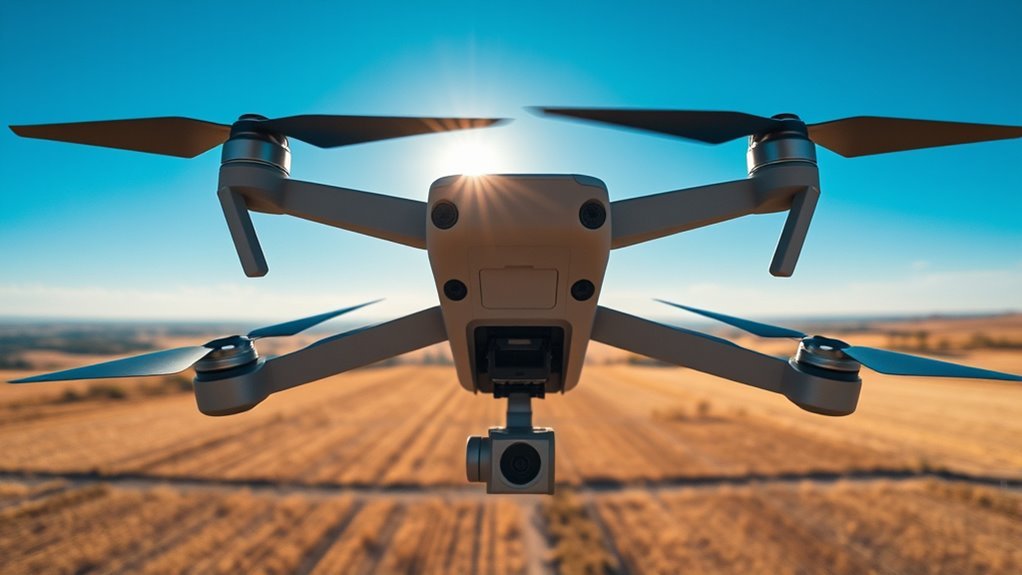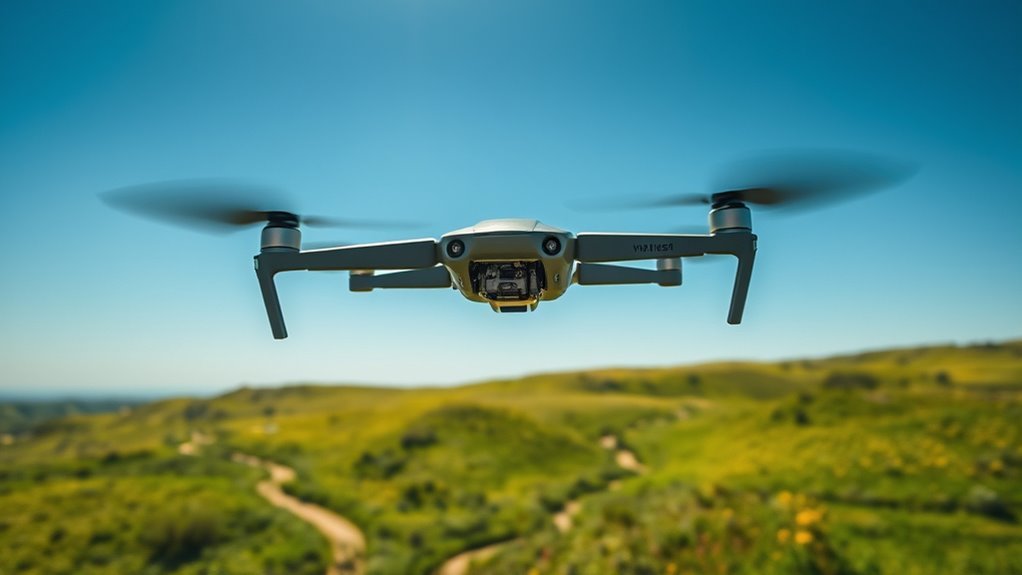Drones operate through a combination of lightweight structures, thrust-generating propulsion systems, and advanced flight controllers. The flight controller processes sensor data to guarantee stable flight and maneuverability. Propellers generate lift, while GPS and inertial measurement units guide navigation. Communication systems enable remote control, often using RF or Wi-Fi for data transmission. Battery technology is critical for managing power and extending flight time. By exploring further, you’ll uncover the intricacies of drone technology and its applications.
Understanding Drone Components

Drones, often referred to as unmanned aerial vehicles (UAVs), consist of several key components that collectively enable their operation. Understanding these components is essential for anyone interested in drone types and their functionality. The frame, typically made of lightweight materials like carbon fiber or plastic, provides structural integrity while minimizing weight. Propulsion systems, including motors and propellers, are important for lift and maneuverability. The battery, often lithium-polymer, supplies power and affects flight time. Additionally, sensors, which can range from cameras to GPS modules, enhance the drone’s capabilities. High-precision sensors are crucial for ensuring accurate data collection in various applications. Component materials are chosen for durability and performance, influencing the drone’s overall efficiency. By grasping these components, you can better appreciate how drones operate and the freedom they offer in various applications. The integration of advanced camera capabilities allows for high-quality visual content, further enhancing the functionality of drones in various contexts.
The Role of Flight Controllers

Precision in flight control is vital for the safe and effective operation of unmanned aerial vehicles. Flight controllers serve as the brain of your drone, processing inputs from various sensors and translating them into commands for the motors. They utilize sophisticated flight algorithms to interpret data and guarantee stability during flight. By implementing advanced stabilization techniques, these controllers maintain the drone’s balance against environmental disturbances. This real-time adjustment allows you to experience smooth and controlled flight, even in challenging conditions. Furthermore, the adaptability of flight controllers empowers you to customize settings according to your specific needs, enhancing your operational freedom. Ultimately, mastering the role of flight controllers is essential for achieving precision and reliability in your aerial adventures. Additionally, the integration of advanced data processing features ensures rapid analysis of flight data, allowing for improved decision-making during operations. The incorporation of high-resolution imaging technologies can also greatly enhance obstacle detection and safety measures, further contributing to the overall effectiveness of flight controllers.
Propulsion Systems Explained

Flight controllers play an essential role in managing a drone’s flight dynamics, but they rely heavily on the efficiency of the propulsion system. Thrust generation is vital, and rotor design directly influences propulsion efficiency. Various motor types—brushless, brushed, and stepper—determine how effectively energy conversion occurs. Understanding aerodynamic forces helps improve weight distribution, ensuring stability during flight. Drone lifting capacities can also affect how effectively a drone can carry different payloads. Fuel sources, whether batteries or fuel cells, impact overall performance and endurance. Additionally, incorporating noise reduction technologies can enhance operational discretion. To maintain peak performance, regular maintenance practices are essential, addressing wear and tear on rotors and motors. By focusing on these components, you can greatly enhance the drone’s capabilities, achieving the freedom of flight you desire. Notably, advancements in battery capacity can significantly influence a drone’s endurance and operational efficiency.
Sensors and Navigation Technologies
Several key sensors and navigation technologies are essential for a drone’s operational effectiveness. These devices work together to guarantee precision and reliability in flight. For instance, GPS provides fundamental location data, while inertial measurement units (IMUs) track movement and orientation. When combined through sensor fusion techniques, these inputs enhance navigation accuracy, allowing drones to operate autonomously or semi-autonomously. Additionally, AI enhances flight safety by enabling real-time obstacle detection through integrated sensors.
Lidar and cameras also play significant roles, enabling obstacle detection and environmental mapping. By integrating these sensors, you’re able to achieve an all-encompassing understanding of the drone’s surroundings. This synergy not only improves flight stability but also empowers you to explore a broader range of applications, from aerial photography to agricultural monitoring, all while enjoying the freedom to navigate complex environments effortlessly. Additionally, the incorporation of advanced AI and autonomous navigation enhances the operational capabilities of drones in complex environments.
Communication Systems and Remote Control
In the domain of drone operation, effective communication systems are essential for remote control. You’ll need to understand the various remote control technologies, the communication frequency bands they utilize, and the signal transmission methods that connect the drone to its operator. Each component plays an important role in ensuring seamless interaction and control over the drone’s functions. Additionally, understanding high-speed quick transfer can enhance the efficiency of data sharing between the drone and the operator. Drones primarily operate on 2.4 GHz and 5.8 GHz frequency bands, which are critical for reliable command transmission and real-time telemetry.
Remote Control Technologies
Although many people might think of drones as simple flying machines, the technology behind their remote control systems is complex and vital for effective operation. You’ll find that remote control interfaces allow for intuitive handling, while wireless signal protocols guarantee reliable communication between the drone and your controller.
| Feature | Description |
|---|---|
| Remote Control Interfaces | User-friendly designs for easy navigation |
| Wireless Signal Protocols | Standards guaranteeing stable connections |
| Range | Distance the drone can operate from the controller |
| Latency | Delay between command and response |
| Battery Life | Duration the remote can operate before needing a charge |
Understanding these elements is essential for harnessing the true potential of your drone, enhancing your freedom to explore the skies.
Communication Frequency Bands
When operating a drone, understanding communication frequency bands is vital, as they directly influence the reliability and responsiveness of your control system. Typically, drones operate within the 2.4 GHz and 5.8 GHz bands, each offering unique advantages and challenges. The 2.4 GHz band provides longer range but is prone to signal interference from other devices, whereas the 5.8 GHz band offers higher data rates with reduced interference, albeit at a shorter range. Familiarity with communication protocols is important; they dictate how your drone interprets signals and guarantees seamless control. By selecting the appropriate frequency band and understanding potential signal interference, you can enhance your drone’s performance and maintain the freedom of flight you desire.
Signal Transmission Methods
Understanding communication frequency bands sets the stage for comprehending signal transmission methods that enable effective drone operation. You’re likely aware that signal modulation plays an essential role in transmitting data between the drone and its controller. Various transmission protocols, such as Wi-Fi, RF, and LTE, are employed, each with its unique advantages and limitations. For instance, RF is often preferred for long-range control due to its robustness against interference, while Wi-Fi allows for high-data-rate video streaming. The choice of protocol impacts latency and range, which are vital for precise maneuvers. Ultimately, mastering these signal transmission methods empowers you to maximize your drone’s capabilities and guarantees a seamless flying experience, granting you the freedom to explore the skies.
Battery Technology and Power Management
As drone technology advances, the importance of efficient battery systems and power management becomes increasingly evident. You’ll find that battery efficiency directly impacts flight time and operational range, essential for maximizing the drone’s capabilities. Lithium polymer (LiPo) batteries dominate the market due to their high energy density and lightweight properties. However, optimizing power management systems is equally important; they monitor energy consumption, regulate power distribution, and enhance overall performance. Effective power management not only prolongs battery life but also guarantees that critical systems remain functional during flight. As you explore drone applications, understanding these technologies will empower you to select the right drone for your needs, providing greater freedom in your aerial endeavors.
Flight Mechanics and Aerodynamics
Although many might think of drones as simple flying devices, their operation hinges on complex principles of flight mechanics and aerodynamics. For effective lift generation, rotor design must optimize airfoil shape to enhance aerodynamic efficiency, reducing drag while maximizing thrust. Thrust vectoring plays a critical role in maneuverability, enabling precise control during flight dynamics. Stability control systems counteract wind resistance, ensuring the drone maintains its intended path despite external disturbances. By analyzing these factors, you can understand how performance optimization is achieved in drone operation. Each component, from rotor configuration to electronic stabilization, works in concert to enhance overall efficiency and responsiveness, allowing for a seamless flying experience that embodies the freedom of flight. Additionally, aerodynamic design and shape are crucial for minimizing drag and enhancing flight speeds. Furthermore, understanding signal attenuation is essential for ensuring reliable communication during drone operations in varied environments.
Applications of Drones in Various Industries
The advancements in flight mechanics and aerodynamics have paved the way for diverse applications of drones across various industries. In agricultural monitoring, drones provide real-time insights into crop health, optimizing yields. High-resolution imaging enables farmers to detect subtle plant stresses and make informed decisions. Aerial photography has revolutionized marketing and media by capturing stunning visuals from unique perspectives. In disaster response, drones assess damage and locate survivors quickly, streamlining rescue operations. Wildlife conservation efforts benefit from drones that monitor endangered species without disturbing their habitats. Infrastructure inspection is enhanced with drones detecting structural issues efficiently. Meanwhile, package delivery is becoming more common, promising swift logistics solutions. Drones are also making waves in entertainment services and military surveillance, showcasing their versatility and the freedom to innovate across sectors. Additionally, real-time monitoring through drones can significantly enhance agricultural practices by enabling precise interventions based on live data analysis.
Frequently Asked Questions
Can Drones Operate in Adverse Weather Conditions?
Yes, drones can operate in adverse weather conditions, but their performance may decline due to weather impact. Factors like wind, rain, and snow can affect stability, battery life, and sensor accuracy, limiting operational effectiveness.
How Far Can Drones Typically Fly From Their Controller?
Drones typically fly up to several miles from their controller, depending on flight range and signal strength. Factors like environmental interference can reduce this distance, so understanding these variables is essential for effective drone operation.
What Are the Legal Regulations for Drone Usage?
When using drones, you’ve got to take into account legal regulations, including obtaining drone insurance and addressing privacy concerns. These rules guarantee responsible operation while allowing you the freedom to explore aerial possibilities safely and legally.
How Are Drones Maintained and Repaired?
Did you know that over 60% of drone failures stem from inadequate maintenance? Regular drone inspections and adherence to maintenance procedures can greatly enhance performance and longevity, ensuring your aerial device remains reliable and efficient.
What Are the Safety Measures for Drone Operation?
When operating drones, you should prioritize pilot training and conduct thorough risk assessments. Understanding airspace regulations and implementing safety protocols helps minimize hazards, ensuring responsible freedom in your drone activities while protecting people and property.

